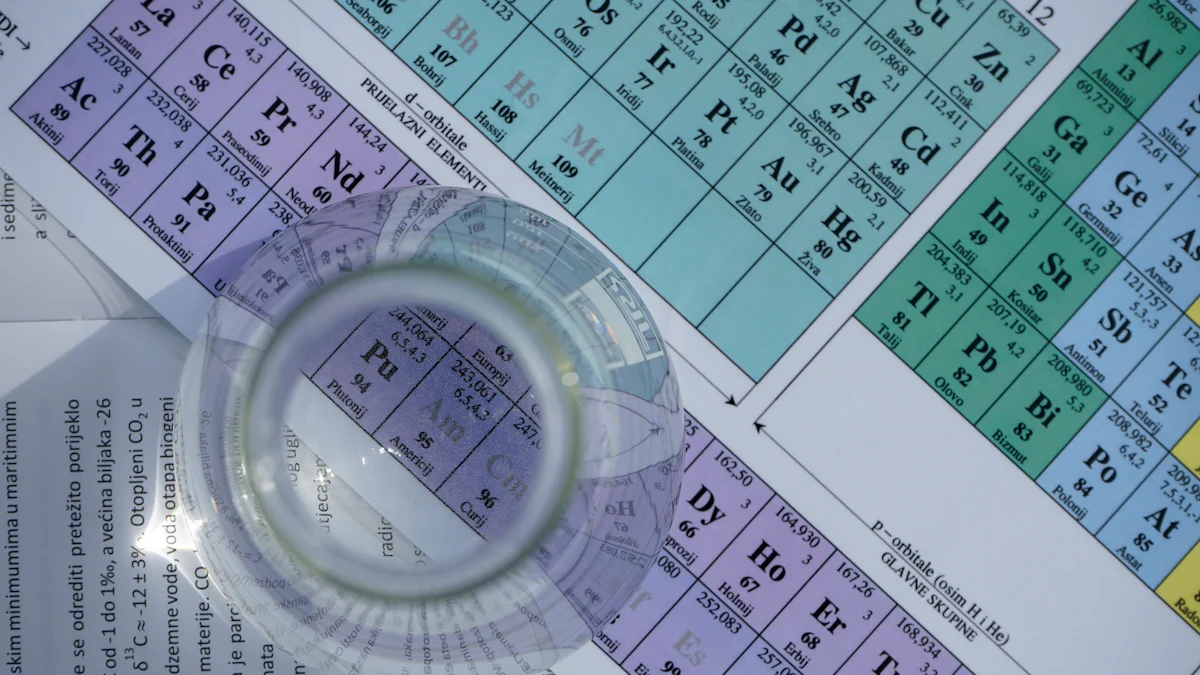The Elements Book: A Visual Encyclopedia of the Periodic Table

The Periodic Table of Elements serves as a crucial tool in understanding the world of chemistry. Each chemical element, defined by its atomic number, represents a unique type of atom. The table organizes these elements into rows and columns based on shared properties, helping chemists predict chemical reactions and understand trends. Dmitri Mendeleev introduced the first version of this table in 1869, leaving gaps for undiscovered elements and predicting their properties. This innovative approach revolutionized how scientists classify and study chemical elements.
Understanding Elements

Definition and Characteristics
Chemical elements form the foundation of all matter. Each element consists of atoms with a unique atomic number. The atomic number represents the number of protons in an atom's nucleus. This number serves as the defining characteristic of each element. For example, hydrogen has an atomic number of 1, while oxygen has an atomic number of 8.
Atomic Structure
Atoms consist of three main particles: protons, neutrons, and electrons. Protons and neutrons reside in the nucleus, while electrons orbit the nucleus. The number of protons defines the element's atomic number and determines the chemical symbol. Electrons influence the element's chemical behavior and bonding properties. The arrangement of electrons around the nucleus follows specific patterns, which contribute to the element's characteristics.
Isotopes and Allotropes
Isotopes are variations of an element that have the same number of protons but different numbers of neutrons. These differences in neutron count lead to variations in atomic mass. For example, carbon has isotopes such as carbon-12 and carbon-14. Isotopes play a crucial role in scientific research and applications. Allotropes refer to different structural forms of the same element. Carbon, for instance, exists as diamond and graphite, showcasing diverse properties despite sharing the same chemical symbol.
Classification of Elements
The periodic table classifies elements into distinct categories based on shared properties. This classification aids in understanding the periodic table and predicting chemical reactions.
Metals, Nonmetals, and Metalloids
Elements fall into three primary categories: metals, nonmetals, and metalloids. Metals exhibit properties like conductivity, malleability, and luster. Nonmetals, in contrast, often lack these metallic properties. Metalloids possess characteristics of both metals and nonmetals. Silicon, a metalloid, finds extensive use in electronics due to its unique properties.
Natural vs. Synthetic Elements
Natural elements occur naturally on Earth and form the majority of the periodic table. These elements include familiar ones like oxygen, nitrogen, and iron. Synthetic elements, however, are created in laboratories through nuclear reactions. These elements often have higher atomic numbers and shorter lifespans. Scientists continue to explore the synthesis of new elements, expanding the periodic table and deepening our understanding of atomic structure.
The Periodic Table Structure

Layout and Organization
The Periodic Table organizes chemical elements in a way that reveals their properties and relationships. This layout helps you understand how elements behave and interact.
Periods and Groups
Periods represent horizontal rows in the table. Each period shows a progression of elements with increasing atomic numbers. As you move across a period, you notice changes in properties like atomic radius and ionization energy. Groups, or families, are vertical columns. Elements in the same group share similar chemical properties due to having the same number of valence electrons.
Blocks of the Periodic Table
The table divides into blocks based on electron configurations. These blocks include the s-block, p-block, d-block, and f-block. Each block highlights specific periodic trends in atomic structure and reactivity. Understanding these blocks helps you predict how elements will behave in chemical reactions.
Trends in the Periodic Table
The periodic table generally displays several important trends. These trends help you predict and explain the behavior of elements.
Atomic Radius
Atomic radius measures the size of an atom. As you move from left to right across a period, the atomic radius decreases. This occurs because electrons are added to the same energy level, pulling them closer to the nucleus. Moving down a group, the atomic radius increases due to additional electron shells. This increase results in larger atoms.
Ionization Energy
Ionization energy refers to the energy required to remove an electron from an atom. Across a period, ionization energy increases. Atoms hold onto their electrons more tightly as they become more stable. Down a group, ionization energy decreases. Electrons are farther from the nucleus and easier to remove.
Electronegativity
Electronegativity measures an atom's ability to attract electrons in a bond. Across a period, electronegativity increases. Atoms become more eager to gain electrons for stability. Down a group, electronegativity decreases. Larger atomic radii make it harder for atoms to attract electrons.
Understanding these periodic trends in atomic radius, ionization energy, and electronegativity helps you grasp the periodic properties of elements. The periodic trends in electron configuration also play a crucial role in predicting chemical behavior.
Historical Development
Early Attempts at Classification
Lavoisier's List of Elements
Antoine Lavoisier made a significant contribution in 1789. Lavoisier grouped elements based on their properties. The classification included gases, non-metals, metals, and earths. This approach laid the groundwork for future classifications.
Newlands' Law of Octaves
John Newlands introduced the Law of Octaves in 1865. Newlands noticed a pattern among elements. Elements with atomic weights differing by seven showed similarities. This observation highlighted the periodic nature of elements.
Mendeleev's Periodic Table
Predictions and Discoveries
Dmitri Mendeleev revolutionized the study of elements in 1869. Mendeleev arranged elements by increasing atomic weight. This arrangement revealed patterns among elements. Mendeleev left spaces for undiscovered elements. These predictions proved accurate as new elements were found.
Modern Periodic Law
The Modern Periodic Law emerged from Mendeleev's work. This law states that elements show periodic changes in properties. The arrangement by atomic weight evolved into the Modern Periodic Table. The table now organizes elements by atomic number. The Modern Periodic Table remains a vital tool in chemistry. Chemists use the table to understand chemical behavior and predict reactions.
Applications of the Periodic Table

In Chemistry and Industry
The Periodic Table plays a vital role in both chemistry and industry. This tool helps you understand how elements interact and behave.
Predicting Chemical Reactions
Chemists use the Periodic Table to predict chemical reactions. The arrangement of elements allows you to see patterns in reactivity. Elements in the same group often react similarly. This knowledge helps in designing new compounds and materials. Industries rely on these predictions for efficient production processes.
Material Science
Material science benefits greatly from the Periodic Table. Understanding the properties of elements aids in developing new materials. Metals, nonmetals, and metalloids offer unique characteristics. These characteristics are essential in creating alloys, semiconductors, and polymers. The table provides a roadmap for innovation in technology and manufacturing.
In Education and Research
The Periodic Table serves as an invaluable educational tool. Students and researchers use it to explore the world of chemistry.
Teaching Tool
Teachers use the Periodic Table to introduce students to chemical concepts. The table's structure makes complex information accessible. Students learn about atomic numbers, element groups, and periodic trends. This foundational knowledge supports further study in science.
Research and Development
Researchers depend on the Periodic Table for scientific advancement. The table helps identify relationships between elements. This understanding leads to discoveries in fields like pharmacology and environmental science. The table remains a cornerstone for innovation and exploration in research.
FAQs and Interesting Facts
Common Questions
Why is the periodic table important?
The periodic table is a vital tool in chemistry. It organizes elements by atomic number, revealing patterns in properties. Chemists use the table to predict chemical reactions and understand element behavior. The table's structure helps identify relationships between elements.
How are new elements discovered?
Scientists discover new elements through nuclear reactions. These reactions often occur in laboratories. Researchers bombard target atoms with particles, creating new elements. Mendeleev predicted undiscovered elements and left gaps in the table. Modern scientists continue this exploration.
Did You Know?
Elements Named After Scientists
Many elements honor scientists. Einsteinium celebrates Albert Einstein. Meitnerium honors Lise Meitner, an Austrian-Swedish physicist. These names recognize contributions to science.
The Most Abundant Elements
Oxygen and silicon dominate Earth's crust. Hydrogen is abundant in the universe. These elements form the building blocks of life and matter. Understanding these elements helps explain natural phenomena.
Periodic Table Learning Resources
Interactive Periodic Table
Explore the world of chemistry with an Interactive Periodic Table. This tool allows you to engage with elements in a dynamic way. Online tools and apps provide detailed information about each element. These resources include atomic numbers, chemical symbols, and properties. You can visualize trends and relationships between elements. Interactive features enhance your understanding of the periodic table's structure.
Online Tools and Apps
Several online platforms offer interactive experiences. Websites like RSC and UNESCO provide valuable resources. These tools help you learn about chemical reactions and properties. Apps available on smartphones and tablets make learning accessible. You can explore elements anytime and anywhere. Interactive quizzes and games make learning fun and engaging.
Periodic Table Lesson Plans
Educators can benefit from comprehensive Periodic Table Lesson Plans. These plans offer structured activities for teaching chemistry concepts. Lesson plans align with educational standards and goals. Teachers can use these resources to create engaging classroom experiences.
Educational Materials
Educational materials support diverse learning styles. Resources from Teachers Pay Teachers and Teach Chemistry offer worksheets and activities. Visual aids like charts and diagrams enhance comprehension. Experiments and hands-on activities bring the periodic table to life. Students gain a deeper understanding of chemical elements and their interactions.
The Periodic Table stands as a vital tool in understanding the world of chemistry. This table organizes chemical elements by atomic number, revealing patterns and relationships. The arrangement allows scientists to predict chemical reactions and understand trends. The table serves as a concise catalog of all known elements. Exploring the periodic table deepens appreciation for chemistry's role in everyday life. The table's structure offers insights into the properties of elements and their interactions. Embrace the opportunity to explore further and discover the wonders of chemical elements.
See Also
Cosmos: An Illustrated Reference Book
Flora: Botanical Guide to Plant Life
Chronicles: A Comprehensive History

